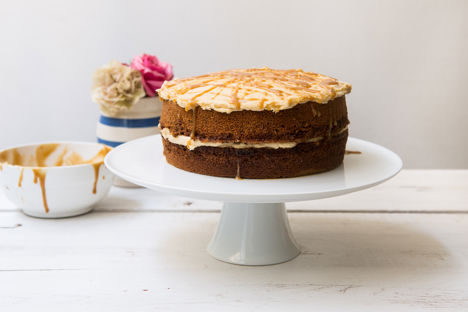Cake encompasses a wide range of sins. . .or delights. There are the cakes which accommodate more and more candles for each year that passes. There are the elaborate little cakes which gaze back at you from a patisserie window or the proud Victoria sponges which follow cucumber sandwiches. There are the fruit muffins for breakfast, stout Eccles cakes at tea time or the decadent gateaux which announces the end to a celebratory meal. Christening cakes, wedding cakes, Christmas cakes and Easter Simnel cakes. They come in all shapes and sizes – but the one thing which cakes have in common is marking an occasion. A cake is rarely something whisked up last-minute. It's something pre-planned, made with care and decorated with love which is why some kind of cake holds a special place in almost everybody's heart.
There are a few basics to master: creaming, lining tins, checking how to tell if a cake is cooked and basic icing. Having these strong skills in your baking repertoire will take you a long way.
Beyond that, there's the option to dip a toe, or fully immerse yourself into the world of baking – from steaming sponges to royal icing there are a countless number of variations and different techniques to explore.
Types of cakes
The Oxford English Dictionary definition of a cake is ‘an item of soft, sweet food made from a mixture of flour, fat, eggs, sugar and other ingredients, baked and sometimes iced or decorated.’
Bearing this in mind, a purist may demand that a cake is a sponge-based bake. Most countries' cuisine has evolved to have a national sponge cake, which might be proudly displayed in bakery windows or grace the table on national holidays. There is Germany's black forest gateau, French roulade and American red velvet cake, for example. In Britain, regions can even be mapped by their own specific teatime treats: Yorkshire parkin, Mancunian Eccles cakes and Welsh cakes, just to name a few.
Over the years, the definition of cake has blurred to embrace a whole host of other treats though: muffins, brownies, patisserie, tortes. A recent trend is also the explosion of gluten-free cakes which veer away from traditional wheat flours and look to alternatives like rice flour, coconut flour or polenta instead.
Variations
Chocolate and cake are such famous friends, there is an entire collection dedicated to Chocolate Cakes on the Great British Chef's website. Aside from cocoa, the other most popular sponge flavouring is vanilla. Don't be restrained by convention though. Lots of dry flavourings can be stirred into a plain sponge mixture - see Marcello Tully's pepper sponge for inspiration, or even look to saffron and matcha tea sponges as a way to introduce both colour and flavour.
Another popular addition to a plain sponge cake is fruit. This can be baked into a cake, or served with it as a filling – either as fresh fruit or jam, or even dolloped on top, as with this flourless lemon cake with rhubarb compote.
Perhaps the most common way of introducing new flavours is through decorative techniques. This might range from flavoured or plain glace icing seen atop of the British fairy cake, to the dramatic mascarpone, cream cheese or butter cream frosting used on American cupcakes – then studded with sweets, fruit or chocolate. Other cakes might use flavoured ganache, fondant icing or even more elaborate touches like sugar flowers or crystallised petals.
Get in touch
Please sign in or register to send a comment to Great British Chefs.


